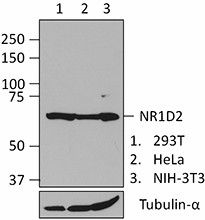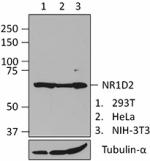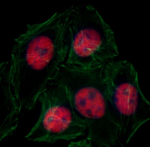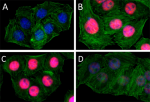- Clone
- W15136A (See other available formats)
- Regulatory Status
- RUO
- Other Names
- Nuclear receptor subfamily 1 group D member 2, BD73, V-erbA-related protein 1-related (EAR-1r), Hs.37288, HZF2, Rev-erb alpha-related receptor (RVR), Rev-erb-beta
- Isotype
- Rat IgG1, κ
- Ave. Rating
- Submit a Review
- Product Citations
- publications

-

Total cell lysate from human 293T cells (lane 1), HeLa cells (lane 2), and mouse NIH-3T3 cells (lane 3) were resolved by electrophoresis, transferred to nitrocellulose, and probed with purified anti-NR1D2 (clone W15136A) antibody. Proteins were visualized using an HRP goat anti-rat IgG antibody and chemiluminescence detection. Purified anti-Tubulin-α (clone 10D8) antibody was used as a loading control. -

HeLa cells were fixed with 4% paraformaldehyde (PFA) for 15 minutes, permeabilized with 0.5% Triton X-100 for three minutes, and blocked with 1% BSA for 60 minutes. Then the cells were intracellularly stained with 1.0 µg/ml purified anti- NR1D2 (clone W15136A) antibody for one hour, followed by staining with Alexa Fluor® 594 conjugated anti-rat IgG antibody (red) for one hour at room temperature. Actin filaments were labelled with Alexa Fluor® 488 conjugated Phalloidin (green). Nuclei were counterstained with DAPI (blue). The image was captured with a 60X objective.
| Cat # | Size | Price | Quantity Check Availability | Save | ||
|---|---|---|---|---|---|---|
| 689402 | 100 µg | 212€ | ||||
Nuclear receptor subfamily 1, group D, member 2 (NR1D2), also known as Rev-ErbA β, is a member of the nuclear hormone receptor family. This protein can modulate gene expression by directly binding to DNA response elements within the promotor of its target genes as either monomers or homodimers. NR1D2 is well known to function as a transcriptional repressor. By complexing with heme, NR1D2 coordinates circadian rhythm and controls lipid metabolism. NR1D2 can directly repress the expression of core clock components ARNTL/BMAL1 and CLOCK, to coordinate circadian rhythm. In addition, NR1D2 can regulate lipid and energy homeostasis in skeletal muscles via repression of lipid metabolism and myogenesis-related genes such as CD36, FABP, SCD1 and MSTN. It is also involved in the regulation of hepatic lipid metabolism through the suppression of APOC3 expression. Not only as a repressor, NR1D2 also acts as a transcriptional activator; it can activate the transcription of the sterol regulatory element-binding protein 1 (STEBF1) and the inflammatory mediator IL-6 in skeletal muscle. Alternatively spliced transcript variants of NR1D2 gene have been described.
Product DetailsProduct Details
- Verified Reactivity
- Human, Mouse
- Antibody Type
- Monoclonal
- Host Species
- Rat
- Immunogen
- Partial human NR1D2 recombinant protein (196-399 a.a.) expressed in E. coli.
- Formulation
- Phosphate-buffered solution, pH 7.2, containing 0.09% sodium azide.
- Preparation
- The antibody was purified by affinity chromatography.
- Concentration
- 0.5 mg/ml
- Storage & Handling
- The antibody solution should be stored undiluted between 2°C and 8°C.
- Application
-
WB - Quality tested
ICC - Verified - Recommended Usage
-
Each lot of this antibody is quality control tested by Western blotting. For Western blotting, the suggested use of this reagent is 0.5 - 2.0 µg/ml. For immunocytochemistry, a concentration range of 1.0 - 5.0 μg/ml is recommended. It is recommended that the reagent be titrated for optimal performance for each application.
- RRID
-
AB_2629653 (BioLegend Cat. No. 689402)
Antigen Details
- Structure
- 579 amino acids, predicted molecular weight of 65 kD. Contains two N-terminal zinc finger domains responsible for DNA binding.
- Distribution
-
Nucleus.
- Function
- NR1D2 belongs to the nuclear hormone receptor family and acts as a transcriptional repressor. NR1D2 participates in the regulation of circadian rhythms and energy homeostasis.
- Interaction
- Forms a DNA-binding homodimer. Interacts with NCOA5, KAT5, HDAC1, and ZNHIT1.
- Biology Area
- Cell Biology, Neuroscience, Neuroscience Cell Markers, Transcription Factors
- Molecular Family
- Nuclear Markers, Steroid Receptors/Nuclear Receptors
- Antigen References
-
1. Cho H, et al. 2012. Nature 485:123.
2. Gupta N, Ragsdale SW. 2011. J. Biol. Chem. 286:4392.
3. Bois-Joyeux B, et al. 2000. DNA Cell Biol. 19:589-99.
4. Burke L, et al. 1996. Nucleic Acids Res. 24:3481.
5. Giambiagi N, et al. 1995. Biochem. Mol. Biol. Int. 37:1091.
6. Bonnelye E, et al. Cell Growth Differ. 5:1357. - Gene ID
- 9975 View all products for this Gene ID
- UniProt
- View information about NR1D2 on UniProt.org
Related Pages & Pathways
Pages
Related FAQs
Other Formats
View All NR1D2 Reagents Request Custom Conjugation| Description | Clone | Applications |
|---|---|---|
| Purified anti-NR1D2 | W15136A | WB,ICC |
| Alexa Fluor® 594 anti-NR1D2 | W15136A | ICC |
Compare Data Across All Formats
This data display is provided for general comparisons between formats.
Your actual data may vary due to variations in samples, target cells, instruments and their settings, staining conditions, and other factors.
If you need assistance with selecting the best format contact our expert technical support team.
-
Purified anti-NR1D2

Total cell lysate from human 293T cells (lane 1), HeLa cells... 
HeLa cells were fixed with 4% paraformaldehyde (PFA) for 15 ... -
Alexa Fluor® 594 anti-NR1D2

HeLa cells were fixed with 4% paraformaldehyde (PFA) for 15...
 Login / Register
Login / Register 







Follow Us